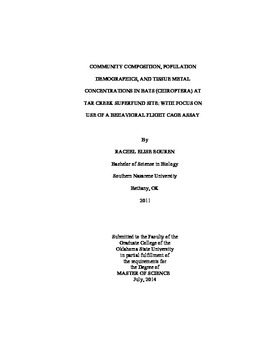| dc.description.abstract | My goals were to: 1) determine community structure and population demographics of Chiroptera within Tar Creek Superfund Site, an area contaminated with lead (Pb), zinc (Zn), and cadmium (Cd), 2) analyze liver, kidney, and hair for metal concentrations in bats from contaminated and reference sites, and 3) develop a behavioral assay to identify differences in flight ability in bats from the contaminated site and a reference site. I hypothesized that: 1) the bat community from the contaminated site would have lower diversity and evenness, 2) bats collected within the contaminated area would have higher levels of Pb, Zn, and Cd in tissues, and 3) lower maneuverability and willingness to fly compared to bats from reference sites. Mist netting occurred June-September 2012 and May-September 2013 at two sites within Tar Creek Superfund Site (TC, BC) and two reference sites within Oologah Wildlife Management Area (PLM, PAN). Both communities were dominated by Eastern Red Bats (Lasiurus borealis). Contaminated sites had lower, but not significantly different diversity (Simpson's (D). Kidney Zn concentrations were significantly different for males from TC compared to BC males (p = 0.02), but were not significantly different from reference sites. Hair Zn concentrations in PAN males was significantly different compared to PLM males (p = 0.04), but not compared to contaminated sites. Finally, hair Pb concentration was significantly higher in females from BC than from TC (p = 0.005), and hair Pb concentrations in PAN males were significantly different compared to PLM males (p = 0.0074). Bats from PLM showed predictably strong relationships between flight time and obstacles dropped (R2 = 0.6945), and flight time and movement between sections of the cage (R2 = 0.9758), whereas bats from the contaminated area showed weaker relationships between flight time and obstacles dropped (R2 = 0.0004) and flight time and movement between sections of the cage (R2 = 0.2422). I demonstrated that a noninvasive behavioral assay can distinguish differences in flight ability in bats from a contaminated site compared to a reference site, showed differences in population demography, and provided tissue metal concentrations for bats from the Tar Creek Superfund Site. | |
